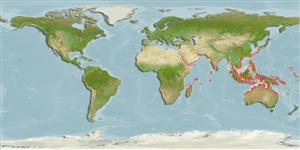>
Kurtiformes (Nurseryfishes, cardinalfishes.) >
Apogonidae (Cardinalfishes) > Apogoninae
Etymology: Archamia: Greek, arche = old + Greek, amia = a kind of fish (Ref. 45335); bleekeri: Named for Ofer Gon, JLB Institute of Ichthyology, who first noticed the possible differences between A. lineolata and A. goni (Ref. 31551).
More on author: Günther.
Environment: milieu / climate zone / depth range / distribution range
Ecologie
marien rifbewoner; diepte 10 - 30 m (Ref. 90102). Tropical
Indo-West Pacific: east coast of Africa south to Durban, and eastward to the Gulf of Oman, India, Sri Lanka, Thailand, Singapore, Indonesia, Taiwan, and Queensland.
Grootte / Gewicht / Leeftijd
Maturity: Lm ? range ? - ? cm
Max length : 12.6 cm TL mannelijk / geslacht onbekend; (Ref. 125969); max. gepubliceerd gewicht: 23.20 g (Ref. 125969)
Dorsale stekels (totaal): 8; Dorsale zachte stralen (totaal): 9; Anale stekels 2; Anale zachte stralen: 15 - 17. Color in life silver gray, translucent on body, variable amount of bright yellow pigment on head and body, most commonly on snout, jaws and throat; side of snout sometimes with dark dots; black caudal spot pupil size or smaller; fins pale; diffuse orange stripe above anal-fin base. Rays: dorsal rays VII,9; anal II,15-17 (usually 16); pectoral 14 (rarely 13 or 15). Lateral line scales 25 + 3-4; median predorsal scales 5-6 (rarely 5). Gill rakers 5-7 + 15-18. Body depth 2.6-3.2 in SL; body width 2.2-2.8 in depth; eye diameter 2.7-4.4 in HL; first dorsal spine 1.1-1.4 in second spine; second dorsal spine 2.2-3.0; third dorsal spine 2.3-3.0 in HL; spine of second dorsal fin 2.6-3.1, and second anal spine 3.4-4.5 in HL; pelvic-fin length 4.5-5.8, and caudal-peduncle length 4.5-5.4 in SL. Distance from insertion of pelvic spine to anal-fin origin 4.5-5.7 in SL. Preopercular edge smooth except for serrae at angle and on posterior half of ventral edge. Scaly sheath along anal-fin base poorly developed.
Found in coastal, mangrove zones and thought to enter rivers, but also found with shipwrecks in deeper water laying on muddy substrates (Ref. 48635); also on reefs, over sandy and muddy bottoms in silty conditions (Ref. 54391) Forms aggregations that hover above rocky outcrops (Ref 90102). Feeds on fish eggs and larvae, shrimps, and pelagic polychaetes (Ref. 31551).
Levenscyclus en paargedrag
Maturiteit | Voortplanting | Paaien | Eieren | Fecunditeit | Larven
Are mouthbrooders (Ref. 240). Distinct pairing during courtship and spawning (Ref. 205).
Gon, O. and J.E. Randall, 2003. Revision of the Indo-Pacific cardinalfish genus Archamia (Perciformes: Apogonidae), with description of a new species. Indo-Pac. Fish. (35):49 p. (Ref. 54391)
Status op de Rode Lijst van het IUCN (Ref. 130435)
Gevaar voor de mens
Harmless
Gebruik door de mens
Meer informatie
ReferentiesAquacultuurAquacultuurprofielKweeklijnenGeneticaElectrophoresesErfelijkheidZiektesVerwerkingNutrientsMassaconversie
Tools
Speciale rapporten
Download XML
Internetbronnen
Estimates based on models
Preferred temperature (Ref.
123201): 25.1 - 29.1, mean 28.2 °C (based on 620 cells).
Fylogenetische diversiteitsindex (Ref.
82804): PD
50 = 1.0000 [Uniqueness, from 0.5 = low to 2.0 = high].
Bayesian length-weight: a=0.01479 (0.00690 - 0.03171), b=3.09 (2.91 - 3.27), in cm total length, based on LWR estimates for this (Sub)family-body shape (Ref.
93245).
Trofisch niveau (Ref.
69278): 3.7 ±0.51 se; based on food items.
Weerstandsvermogen (Ref.
120179): Hoog, minimale populatieverdubbelingstijd minder dan 15 maanden (Preliminary K or Fecundity.).
Fishing Vulnerability (Ref.
59153): Low vulnerability (10 of 100).
Nutrients (Ref.
124155): Calcium = 146 [72, 253] mg/100g; Iron = 1.11 [0.63, 1.95] mg/100g; Protein = 18.5 [17.3, 19.7] %; Omega3 = 0.129 [0.069, 0.235] g/100g; Selenium = 30.3 [14.7, 62.9] μg/100g; VitaminA = 90.9 [28.3, 308.7] μg/100g; Zinc = 1.57 [1.00, 2.33] mg/100g (wet weight);
